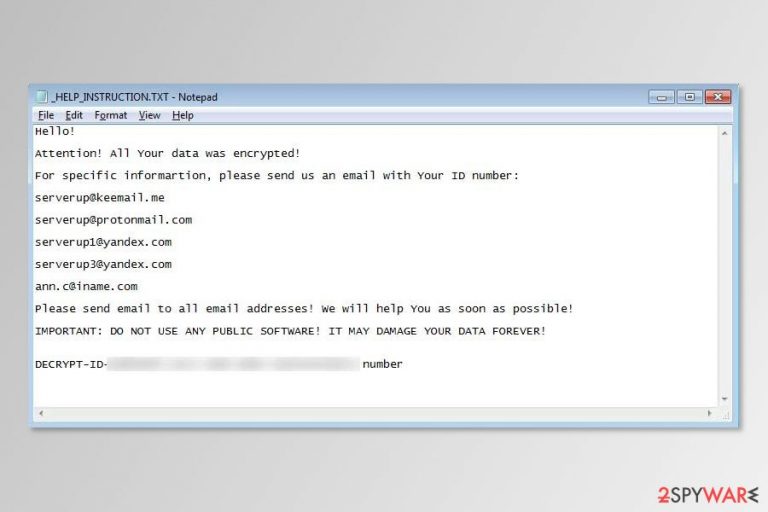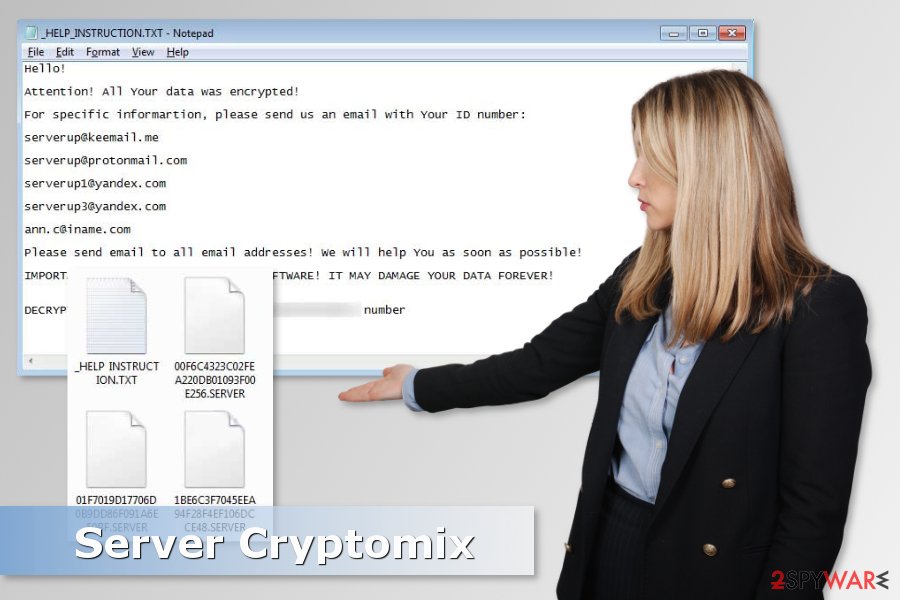Server ransomware (Decryption Methods Included) - Virus Removal Instructions
Server virus Removal Guide
What is Server ransomware?
Cryptomix is back with Server ransomware virus

Server ransomware is a new version of a CryptoMix virus.[1] This file-encrypting malware uses .SERVER file extension to make files inaccessible on the targeted computer. Following the encryption, crypto-virus drops a ransom note called _HELP_INSTRUCTION.TXT where crooks ask to send victim’s ID number in order to learn more about data recovery possibilities.
Server Cryptomix ransomware uses AES encryption cipher to corrupt various documents, audio, video, image and similar data. However, it not only adds a new file extension but also renames the files with a random string of letters and numbers. Therefore, it makes a total mess.
Unfortunately, files encrypted by Server virus cannot be decrypted yet. Developers use a sophisticated encryption which hasn’t been cracked by malware researchers. However, following the instructions provided in the ransom note is still not advisable:
Hello!
Attention! All Your data was encrypted!
For specific informaiton, please the send us an email with Your ID number:
serverup@keemail.me
serverup@protonmail.com
serverup1@yandex.com
serverup3@yandex.com
ann.c@iname.com
Please the send email to all email addresses The! We will help You as soon as possible !
IMPORTANT: DO NOT USE ANY PUBLIC SOFTWARE ! IT MAY DAMAGE YOUR DATA FOREVER!
DECRYPT-ID- [id] number
The name and the content of the ransom note are almost the same as we have already seen in the notes used by previous Cryptomix versions. The only significant change is new contact email addresses which are changing from one version to another. As you can see in the quoted ransom note, criminals now use these five email addresses:
- serverup@keemail.me
- serverup@protonmail.com
- serverup1@yandex.com
- serverup3@yandex.com
- ann.c@iname.com
Security specialists want to discourage you from contacting developers of the Server Cryptomix virus. You will be asked to pay several hundreds of dollars in Bitcoins.[2] However, it does not guarantee that you will be given a decryption software. There were many cases were hackers disappeared or blackmailed into paying more money.
Therefore, instead of risking to increase your damage, you should remove Server ransomware from the computer. In order to do it safely, you have to use a professional security software and let it terminate all suspicious components from the system.
We recommend FortectIntego for the Server ransomware removal. However, you can employ any other professional tools. If you cannot download, install or run security program, please follow the guide given at the end of the article to disable the virus first.

Spam emails might include ransomware executable
Ransomware viruses typically spread via malicious spam emails. With the help of social engineering, cyber criminals trick people into opening an obfuscated attachment which contains malware payload.
However, security specialists from avirus.hu[3] advise being careful with software downloads and updates, click-bait ads and other suspicious links, buttons or pop-ups found on the web. “Too good to be true” offers and security alerts usually include malicious content.
Finally, you should also keep your software updated and protect your PC with reputable antivirus. Additionally, creating backups is also needed. In case of the cyber attack, you won’t lose the most important data.
Delete Server ransomware from the machine correctly
To remove Server virus from the computer, you have to obtain a reputable malware removal software and scan the system with it. The 2-spyware team recommends using FortectIntego, SpyHunter 5Combo Cleaner or Malwarebytes because these tools are powerful enough to find and delete ransomware-related entries entirely.
However, Server Cryptomix removal might be complicated due to virus’s structure and functionality. Thus, before you start, you should reboot the device into Safe Mode to disable the virus. Follow the instructions below:
Getting rid of Server virus. Follow these steps
Manual removal using Safe Mode
To get rid of the Server ransomware without problems, you should reboot the device into Safe Mode first:
Important! →
Manual removal guide might be too complicated for regular computer users. It requires advanced IT knowledge to be performed correctly (if vital system files are removed or damaged, it might result in full Windows compromise), and it also might take hours to complete. Therefore, we highly advise using the automatic method provided above instead.
Step 1. Access Safe Mode with Networking
Manual malware removal should be best performed in the Safe Mode environment.
Windows 7 / Vista / XP
- Click Start > Shutdown > Restart > OK.
- When your computer becomes active, start pressing F8 button (if that does not work, try F2, F12, Del, etc. – it all depends on your motherboard model) multiple times until you see the Advanced Boot Options window.
- Select Safe Mode with Networking from the list.

Windows 10 / Windows 8
- Right-click on Start button and select Settings.

- Scroll down to pick Update & Security.

- On the left side of the window, pick Recovery.
- Now scroll down to find Advanced Startup section.
- Click Restart now.

- Select Troubleshoot.

- Go to Advanced options.

- Select Startup Settings.

- Press Restart.
- Now press 5 or click 5) Enable Safe Mode with Networking.

Step 2. Shut down suspicious processes
Windows Task Manager is a useful tool that shows all the processes running in the background. If malware is running a process, you need to shut it down:
- Press Ctrl + Shift + Esc on your keyboard to open Windows Task Manager.
- Click on More details.

- Scroll down to Background processes section, and look for anything suspicious.
- Right-click and select Open file location.

- Go back to the process, right-click and pick End Task.

- Delete the contents of the malicious folder.
Step 3. Check program Startup
- Press Ctrl + Shift + Esc on your keyboard to open Windows Task Manager.
- Go to Startup tab.
- Right-click on the suspicious program and pick Disable.

Step 4. Delete virus files
Malware-related files can be found in various places within your computer. Here are instructions that could help you find them:
- Type in Disk Cleanup in Windows search and press Enter.

- Select the drive you want to clean (C: is your main drive by default and is likely to be the one that has malicious files in).
- Scroll through the Files to delete list and select the following:
Temporary Internet Files
Downloads
Recycle Bin
Temporary files - Pick Clean up system files.

- You can also look for other malicious files hidden in the following folders (type these entries in Windows Search and press Enter):
%AppData%
%LocalAppData%
%ProgramData%
%WinDir%
After you are finished, reboot the PC in normal mode.
Remove Server using System Restore
If the previous method did not help, you should try System Restore:
-
Step 1: Reboot your computer to Safe Mode with Command Prompt
Windows 7 / Vista / XP- Click Start → Shutdown → Restart → OK.
- When your computer becomes active, start pressing F8 multiple times until you see the Advanced Boot Options window.
-
Select Command Prompt from the list

Windows 10 / Windows 8- Press the Power button at the Windows login screen. Now press and hold Shift, which is on your keyboard, and click Restart..
- Now select Troubleshoot → Advanced options → Startup Settings and finally press Restart.
-
Once your computer becomes active, select Enable Safe Mode with Command Prompt in Startup Settings window.

-
Step 2: Restore your system files and settings
-
Once the Command Prompt window shows up, enter cd restore and click Enter.

-
Now type rstrui.exe and press Enter again..

-
When a new window shows up, click Next and select your restore point that is prior the infiltration of Server. After doing that, click Next.


-
Now click Yes to start system restore.

-
Once the Command Prompt window shows up, enter cd restore and click Enter.
Bonus: Recover your data
Guide which is presented above is supposed to help you remove Server from your computer. To recover your encrypted files, we recommend using a detailed guide prepared by 2-spyware.com security experts.If your files are encrypted by Server, you can use several methods to restore them:
Try Data Recovery Pro to restore encrypted files
While the official decryptor is not released, you should try Data Recovery Pro. This tool might help to restore some of the encrypted files.
- Download Data Recovery Pro;
- Follow the steps of Data Recovery Setup and install the program on your computer;
- Launch it and scan your computer for files encrypted by Server ransomware;
- Restore them.
Take advantage of Windows Previous Versions feature
This Windows feature allows traveling back in computer's time and copying individual files. However, this option is only possible if System Restore was enabled before Server ransomware attack.
- Find an encrypted file you need to restore and right-click on it;
- Select “Properties” and go to “Previous versions” tab;
- Here, check each of available copies of the file in “Folder versions”. You should select the version you want to recover and click “Restore”.
Use ShadowExplorer
If you are lucky enough and ransomware did not delete Shadow Volume Copies of the targeted data, you should use ShadowExplorer for data recovery.
- Download Shadow Explorer (http://shadowexplorer.com/);
- Follow a Shadow Explorer Setup Wizard and install this application on your computer;
- Launch the program and go through the drop down menu on the top left corner to select the disk of your encrypted data. Check what folders are there;
- Right-click on the folder you want to restore and select “Export”. You can also select where you want it to be stored.
A free and safe to use Server Cryptomix decryptor is not available yet.
Finally, you should always think about the protection of crypto-ransomwares. In order to protect your computer from Server and other ransomwares, use a reputable anti-spyware, such as FortectIntego, SpyHunter 5Combo Cleaner or Malwarebytes
How to prevent from getting ransomware
Access your website securely from any location
When you work on the domain, site, blog, or different project that requires constant management, content creation, or coding, you may need to connect to the server and content management service more often. The best solution for creating a tighter network could be a dedicated/fixed IP address.
If you make your IP address static and set to your device, you can connect to the CMS from any location and do not create any additional issues for the server or network manager that needs to monitor connections and activities. VPN software providers like Private Internet Access can help you with such settings and offer the option to control the online reputation and manage projects easily from any part of the world.
Recover files after data-affecting malware attacks
While much of the data can be accidentally deleted due to various reasons, malware is one of the main culprits that can cause loss of pictures, documents, videos, and other important files. More serious malware infections lead to significant data loss when your documents, system files, and images get encrypted. In particular, ransomware is is a type of malware that focuses on such functions, so your files become useless without an ability to access them.
Even though there is little to no possibility to recover after file-locking threats, some applications have features for data recovery in the system. In some cases, Data Recovery Pro can also help to recover at least some portion of your data after data-locking virus infection or general cyber infection.
- ^ New strain of CryptoMix ransomware wreaks havoc. Jalapeno Business Services. Professional IT Management Services.
- ^ Amy Willis. What is bitcoin, how do I buy it and why do ransomware criminals want them?. Metro. News, sport, showbiz, celebrities.
- ^ Avirus. Avirus. Security news .







